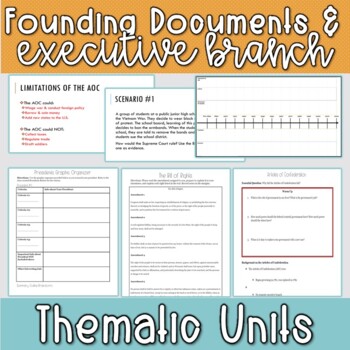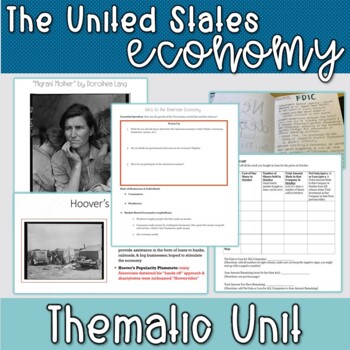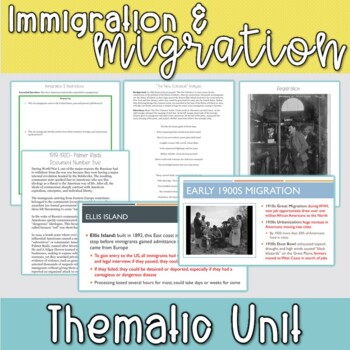US History Semester 1 Ultimate Thematic Course Bundle- Print & Distance Learning
- Zip
Products in this Bundle (37)
showing 1-5 of 37 products
Bonus
Description
"I thought U.S. History was going to be boring," a student told me at the end of semester one, "but the way it's arranged thematically is really interesting." A few days later that student's mother emailed me to let me know her daughter was now so interested in US History and Government that she regularly starts discussions at home with her parents about it. Talk about a teacher's dream.
Ever since I first learned about teaching history by theme rather than straight chronology, I was hooked. When students are free to explore one theme or topic of US History across decades they can make connections and understand history on a much deeper level. They can track trends, discuss continuity, and mark major shifts. Rather than learning about one time period all at once, students are able to really pull at the threads of history to see how one event or movement directly led to another.
My philosophy is that lessons should always be engaging, educational, and very low prep. Therefore, there is not a lot of prep work involved in any of the lessons. You can, however, expect your students to think critically, make deep connections, and analyze quite a few primary and secondary sources. Every lesson is designed to be student-centered, interactive, and interesting.
Each unit also teaches the 11th Grade Common Core Standards for History (reading, writing) and Speaking & Listening. If you want to check out which standards are included in each unit, check out this helpful curriculum map.
How Thematic Units Work: Not to worry- all of the same US History content is covered over the course of the year. But instead of teaching each time period in its entirety chronologically, students learn the material in themes. Within each theme, the curriculum is arranged chronologically so students can see trends and events unfolding over time. For example, in the US Economy Unit, students start with the US economy at the end of the 1800s and learn how it evolved and became more heavily regulated over time. They will even learn about the 2008 recession and evaluate how the US economy is doing today. Wanna see the details of what to expect in each unit? Check out this helpful curriculum map.
Semester One Thematic Units: Founding Documents, Executive Branch, the U.S. Economy, Immigration & Migration
What's Included: Everything you need to teach the content and Common Core skills for Semester One. There are more than 30 individual resources included, most of which contain multiple days of lessons.
Time Period Covered: late 1800s-present
Research Tips & How to Research now included in bundle. Historical Research Paper Materials also now included.
Now Available for Purchase: US History Semester Two Thematic Bundle, which includes the following units: Movements for Equality, American Culture, War & Imperialism. Semester Two Bundle sold separately from the Semester One Bundle.
Distance Learning Note: Now updated for distance learning. All included resources have Google Drive options! Teaching in person? There are print versions as well.
Please view individual lessons prior to purchasing. Many included resources are not editable. Lecture PPTs, exams, quizzes, and most projects are editable.
What to Expect:
- Warm Ups and/or Hook Activities (included in most lessons)
- Essential Questions (included in nearly all lessons)
- Engaging (usually brief) Lectures with Think-Pair-Shares throughout
- Student Fill In Notes for Lectures (including Warm Ups)
- Student Research Activities & Webquests
- Debates & a Socratic Seminar
- Engaging Activities including Instagram-inspired activity, escape room-inspired activities, creative writing, music video analysis, podcasts, etc.
- Lots of Primary Source Analysis!
- American Presidents Project (& several other projects!)
- 4 Unit Exams & Review Guides
- Final Exam & Review Guide
- Daily Lesson Plans
- Calendar of Lessons for 50-minute Periods & for a Hybrid Block Schedule
- So much more!
Materials Needed (if using print versions):
- Class set of included worksheets
- Poster Paper
- Blank sheets of paper or small posters
- Markers or colored pencils
- Highlighters
- Computers for research, activities, & projects
- Ragtime book or free copy here
- Calculators (Stock Market Crash simulation only)
- Manila Folders (Bill of Rights Project only)
To reduce tech issues, please be sure to have the most recent free version of Adobe Reader downloaded. More help linked here.
Note: all Google Drive versions appear in the lesson plans of each individual lesson. As of right now, there is no way to copy a folder in Google so for right now you will need to open each lesson plan and make a copy of each digital resource using the provided links and instructions.
For freebies, teaching tips, and more, sign up for my monthly newsletter and check out my blog!





